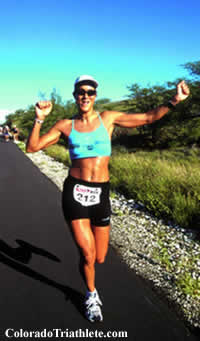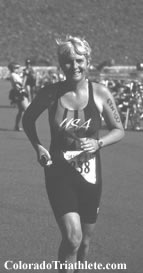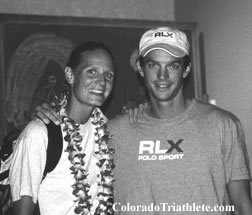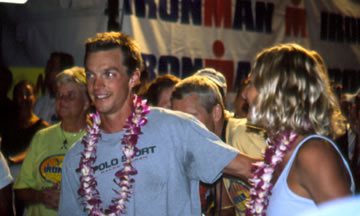Monica Fernandez Takes on the 2000 UltramanStory by Adam Hodges
Photos by Daphne Hougard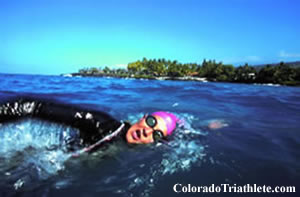 ISSUE #10, April/May 2001 –
ISSUE #10, April/May 2001 –
If you’ve completed four IRONMANs—Hawaii ’97, Germany ’98, Hawaii ’98, Lake Placid ’00—and are no longer feeling challenged enough by the distance, what’s next?
For Boulder resident and native Guatemalan Monica Fernandez, the answer is a three day endurance test over Thanksgiving weekend on the Big Island of Hawaii—the Ultraman.
It’s only fitting that this evolution in the sport takes place near many familiar landmarks of the Hawaii IRONMAN. Despite the similarities of place and disciplines, the races are entities unto themselves. Is the Ultraman twice as hard as the IRONMAN? Is a victory at Ultraman twice as sweet? Just ask Monica Fernandez, this year’s Ultraman champion.
After missing an IRONMAN spot this year, Fernandez, who likes “to challenge my mind and body,” jumped at the opportunity to take her triathlon racing a step further. There is something appealing about going into a race and not knowing if you’ll even get to the finish line at the end. That’s what attracted Fernandez to Ultraman and that test is what provided Fernandez with an experience she’ll never forget and hopes to repeat again in the future.
Day One, 6:30 AM
Fernandez waded into the water near the familiar start of the IRONMAN, only the date was November 24 and the full moon of October had passed. And the 1,500 athletes and concomitant spectators of IRONMAN were back at their respective homes, digesting Thanksgiving meals with bikes still packed in boxes.
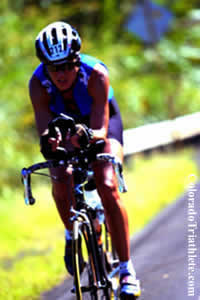
Instead of the snow of Colorado, Fernandez found herself in a land of never ending summer. Even November in Kona can get hot, especially if you’re planning on running a double marathon. But that was still two days away.
The thirty-five swimmers, with support crews nearby, took their cue from the starter and embarked on a journey into the unknown via the coast of the Big Island. The swimmers headed south out of Kailua Bay toward Keauhou.
Ten kilometers—a common run distance. In the Ultraman, ten kilometers is the length of the swim.
Fernandez started the 10K swim knowing that it would be her strongest event. She was focused on a very doable goal time for her—two hours and forty-five minutes. The women’s swim record stood at 2:53. Part of Fernandez’s game plan was to exit the water in Keauhou Bay with the new record before starting the bike. Beyond that little bit of confidence she faced the unknown. In the Ultraman, making the cut-off times each day and getting to the final finish line at the Old Kona Airport is never guaranteed. In fact, the odds are against it.
As Fernandez followed her pace kayak with husband Ran Netzer at the helm, she felt strong and was on the mark over the first five kilometers. Then she encountered the rock that wouldn’t disappear. As if sucked into a swim flume, Fernandez knew she was swimming hard, but she wasn’t gaining any distance. The rock remained fixed below her and Netzer yelled encouragement. Things weren’t supposed to get so hard so soon.
***
Eleven years ago, a 22 year old Fernandez lived in Guatemala City and was an avid smoker, not a triathlete. She had tried five times to quit her two-pack a day habit, but it was swimming that finally helped her make the break from cigarettes. At the time, her brother-in-law was doing triathlons and encouraged her to get into the pool. Swimming came naturally for Fernandez and she improved rapidly with the help of a coach. At first, she would finish a swim workout and light up a cigarette. Eventually she was able to nix that post-swim detriment to her training.
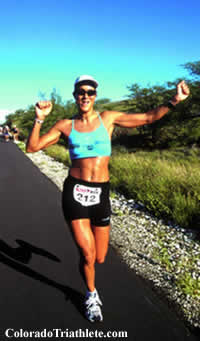
The impetus for the next step came from her swim coach who convinced her to run around the block one day. The next day she ran two laps and her coach brought her a real pair of running shoes to help her along. Her coach then suggested that she try a triathlon.
Her first race was a sprint distance triathlon in Guatemala. She borrowed a bike and walked the entire run course, a fate the older and exceptionally fit Fernandez hoped to avoid at Ultraman.
***
In the water at Ultraman, the struggling Fernandez finally overcame the rock from hell, although the cost was a growing sense of frustration. All she knew over the last half of the swim was that she was horribly off pace and she feared giving up so much time in her strongest event.
Fernandez exited the Pacific with a 10K swim time of 3:28:09, nearly forty-five minutes slower than her predicted time. There would be no record for Fernandez. But what she feared was a huge forfeit of time on her part dissolved when she found out her effort relative to the other competitors. In reality, Fernandez wasn’t alone in the swim flume. Everyone struggled. Currents can play wicked mind tricks on an Ultraman swimmer. But it’s all part of the game.
Fernandez was still in good shape. She emerged out of the ocean as the first woman and fourth person overall.
Day One, 10:00 AM
Out of the water, one leg down, Fernandez and the others started the first of two bike legs—a 90 mile ride full of climbs. Could there be any place more challenging to ride than an island formed by a volcano, full of ups and downs and changes in climates?
Fernandez rolled south on Highway 11 through the town of Captain Cook, named after Captain James Cook, the first westerner to arrive in Hawaii. Down the mountainside from the town is Kealakekua Bay where Cook first arrived on January 17, 1779. If only Cook could have taken swim lessons from Fernandez. Upon a return to the bay on February 14, 1779, Cook was killed by an angry mob, unable to make a short swim out to a boat that was waiting for him. Fernandez had other things to worry about, though—like getting through this bike leg and making the day’s twelve hour cut-off time.
She continued around the southern tip of the island, through the town of Naalehu, and then the long climb up the slope of Kilauea Volcano, through the Kau Desert. Once the racers made it up to Volcanoes National Park at 4,000 feet above sea level, they had another descent to the coast before climbing again to the finish line in the town of Volcano.
Flip a coin. You’d have the same odds as the thirty-five starters did of getting to the end of the first bike leg before the cut-off time. Given the slow swim times, the bikers had even less time to work with. Only seventeen competitors made the twelve hour deadline.
Fernandez made it. With a bike time of 6:25:30 and a total combined time after the first day of 9:53:39, she established herself as the first woman, fifth person overall.
Day Two, 6:30 AM
In the tropics, the day is twelve hours long, with slight variations, no matter the time of year. As the sun rose on November 25, the cyclists headed to the start of the second bike leg—a 171.4 mile stretch from Volcano, around the windward side of the island, along the Hamakua Coast, and to the town of Hawi on the northwestern tip of the Big Island.
From the start in Volcano, the ride starts out with a fun descent into Hilo. However, fun wasn’t what Fernandez was thinking ten minutes into the bike when she flatted. Every competitor must have a support crew. A crew consists of at least two people and a van. The race provides each van with a cell phone to aid in communication between crews and race officials. In the Ultraman, an athlete’s support crew is their lifeline, providing food, water, and equipment. Fernandez had her support crew nearby and she was able to quickly change her tubular and put on more clothes for the descent into Hilo.
Farther down the road, the scenario repeated itself. Only this time, Fernandez’s crew was out of sight. She rode another five miles on the leaking tubular and found a mechanic from another van to help her switch wheels. The new, smaller wheel wasn’t calibrated for her computer and Fernandez could no longer tell what her speed was or how much distance she was gaining. A few women had passed her during the troubles and she redoubled her efforts to gain lost ground.
At 100 miles, Fernandez found herself along the Hamakua Coast with no energy. She bonked hard and again couldn’t find her support crew. They were held up in Hilo buying ice, gas, and a light for her bike in case the day lasted longer than hoped for. She received some aid from the crew of an Australian competitor to tie her over for a while. She and the Aussie traded positions as they biked toward Hawi, careful not to get too close in the non-drafting race but close enough to share the camaraderie.
Once Fernandez’s support crew showed up, she was able to stop, eat a turkey and cheese sandwich, and take an ibuprofen and a salt tablet. She started feeling better, as if returning from the dead and her renewed energy spurred her past several competitors. The wind along the last segment was relatively calm and Fernandez arrived in Hawi with a time of 8:55 for the 171.4 mile ride, good for a new record. Perhaps the island gods were smiling on her perseverance and wanted to make up for the disappointing swim conditions.
But Fernandez went into the Ultraman knowing that she would have to face her weakest event on the third and final day. After 6.2 miles of swimming and 261.4 miles of biking came the double marathon.
***
Gautemala City isn’t exactly the center of the triathlon world. It’s safe to say it rests far on the periphery. Growing up, Fernandez was always involved in sports, but never really trained for anything. Exercise wasn’t emphasized. And the focus was on soccer. Soccer receives all the money and attention in Central America.
After Fernandez started getting involved in triathlons, she ran up against the difficulties of training in a congested and polluted environment. She had to bike between 5:00 and 7:30 AM otherwise get run over by cars. That meant she would get up at 4:00 to prepare and get to the start of her workout. “It was very hard to train,” she says. “Especially at the longer distances.”
Last September, she and Netzer moved to Boulder and since then Fernandez has taken her training to a new level. Dave Scott coaches Fernandez in swimming and biking and coordinates her triathlon schedule. For run-specific coaching, Fernandez works with Janet Runyon, an accomplished ultra-runner and coach.
Fernandez went to Runyon last summer for help through several knee problems. She was able to overcome the injuries, but that meant slowly building up her mileage. The longest run Fernandez did in preparation for Ultraman was merely three hours long. And since she and coach Runyon realized that Fernandez could face the possibility of walking large segments of the Ultraman run, they specifically trained walking, too. On the days Fernandez wasn’t running, she would go out for hour and a half walks.
Of course, this was in addition to her swim and bike training which, surprisingly, mirrored the typical preparation for an IRONMAN distance race—and not much more. But then again, there is only so much time in a week and there is a limit to the body’s ability to recover and go out again for more.
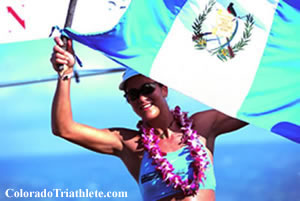
Fernandez did add one day a week where she swam a full 10,000 meters. This usually involved back-to-back Masters workouts. Her longest bike ride was six hours. To add to it all was doing the long bikes in the late fall as the days got shorter and colder. To deal with the climate change from Boulder to Hawaii at the end of November, Fernandez would rely on her comfortableness in heat she gained from living most of her life in Guatemala.
Day Three, 6:00 AM
An earlier start on the final day would give the runners more daylight for the final leg—a double marathon. Yes, that’s 26.2 miles times two, which equals a challenging 52.4 miles from Hawi through the lava fields to the finish at the Old Kona Airport.
The run begins with eighteen miles downhill from Hawi to Kawaihae. Just ask any IRONMAN cyclist how welcome that stretch is before hitting the brutal winds and heat along the Queen K Highway.
Fernandez had never run a marathon outside an IRONMAN and had never run a distance farther than 26.2 miles. Worried about the run, she started out conservatively with the goal of saving her energy for the mentally tough second part. She was the last of the runners at the beginning, but little by little started passing others. She didn’t let herself count miles during the first half of the run. That would have to wait until the second marathon. Her split for the first marathon was 4:25. One marathon down, another to go.
The hills came during the second marathon. Pacers were allowed and Kim McCormick, a member of Fernandez’s support crew, ran with her for a two hour stretch. For the last twenty miles, the bike mechanic who had helped her the day before found a local runner to pace her.
Fernandez joked a bit during the first half of the run, but by the second half, she was all business. The pacer made sure Fernandez conserved her energy and stayed focused on running. And run she did. Even as she suffered in the final miles, she continued to run. “My mind was tired, my body exhausted, and my ankle hurt,” she said. “The closer to the finish, the harder it got.”
Despite the pain of the last three days, especially those arduous miles on the run, Fernandez approached the finish line with a Guatamalan flag in hand and jumped across the line to a victory surely as sweet as any.
With a run time of 9:19:01, Fernandez finished her first Ultraman with a total time of 27:28:09 and a big smile. Plans for more in the future have already entered her mind. And unless Fernandez gets an early season qualifying slot for the Hawaii IRONMAN next year, you will probably find her training through the summer for another go at the Ultraman.

